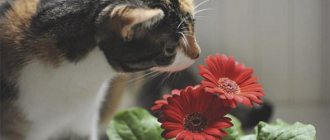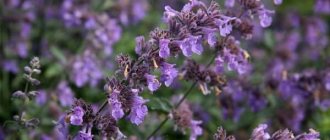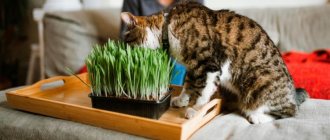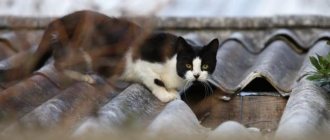The Internet is replete with lists of poisonous houseplants, but all lists are far from complete. It is not possible to cover everything. This makes it easier for cat owners to review the plants they already own for health risks to their cats, rather than trying to memorize long lists.
Not all plants listed as dangerous for cats cause serious poisoning. Therefore, you should not get carried away with these lists. But every cat lover should know about deadly plants.
Every cat lover should also be aware that it is better to be on the safe side than to be under-dressed: in any case, plants should be kept away from cats, since most indoor plants are poisonous to one degree or another.
Many garden and field plants can also cause poisoning of greater or lesser severity in a cat. Most owners are confident that if they take their cat out into nature, it will find useful grass on its own. This is not entirely true. Cats rely on smell and taste and sometimes make mistakes. Sometimes a mistake costs them their lives: plants can be treated with pesticides. Some summer residents scatter rat poison throughout their plots. These poisons are such that the cat's senses do not perceive them as dangerous. Both cats and dogs are often poisoned and die.
Below is a list of the most common poisonous plants. Remember that most of the plants mentioned here have many varieties and species, and different species of the same plant (genus) can differ markedly from each other. If the plants standing on your windowsill are not similar to those you see here in the pictures, this does not mean that your plants are not poisonous! Find out what your indoor flowers are called and it’s better to check not with the pictures, but with the names (1st column).
List of dangerous plants and consequences
Poisonous indoor plants and flowers for cats are found in every third apartment, which pet owners are not aware of.
The final effect depends on the amount and type of active agent in the structure of the leaves or stem. This could be vomiting, fever, bowel dysfunction, or more serious problems. The eagerness of cats to gnaw flowers is not explained by increased interest or disobedience, but by cleansing the stomach of accumulated waste and toxins. The animal does not distinguish between useful and dangerous species, so the opposite effect often occurs.
There are several ways of infection. The most common is the consumption of leaves, flowers or stems of poisonous plants. Toxins also enter the stomach after drinking water from pot stands or eating soil. Particularly dangerous species infect an animal after physical contact with its fur or skin.
Flower shops rarely contain information regarding the toxicity of products, so before bringing a new plant into your pet’s home, find out in detail what effect it will have on the pet and all residents of the apartment.
The table groups the most common indoor plants that pose a threat to your pet.
| Name | What threatens |
| Geranium | Digestive disorder. |
| Evergreen boxwood | Serious intoxications, cases of death have been reported. |
| Azalea | Greens with bright flowers are fraught with danger - an alkaloid that is harmful to both cats and humans. If it enters the stomach, it depresses the central nervous system, provokes convulsions, swelling of the larynx, and disrupts the heart rhythm. |
| Cyclamen | If a leaf or stem gets into the stomach, it will end in vomiting, diarrhea, and abdominal pain. And if the kitten gets to the tubers, the risk of death is high. |
| Caladium | The leaves contain many dangerous acids, even a small amount of them leads to swelling of the larynx and chronic kidney dysfunction. But ingestion of juice is rarely observed due to its “burning” effect: when cats feel discomfort on their mucous membranes, they spit out the liquid. |
| Aloe | Aloe vera, which is healing for humans, belongs to the category of poisonous indoor plants and flowers for cats. Visually manifested as loss of coordination, lethargy, cramps, and diarrhea. |
| Anthurium | The poison is dangerous due to swelling of the mucous membranes and larynx. |
| Begonia | It acts in a similar way to the previous type, leading to burns of the mucous membranes and swelling of the oral cavity. Side effects are caused by the action of oxalic acid. |
| Hydrangea | Contains the most dangerous toxic substances - cyanides, which make breathing difficult, causing asphyxia. |
| Ivy | Decorative species are popular for decorating window sills, but are undesirable for cats - heart, kidney or pulmonary failure is guaranteed. |
| Sensevieria or pike tail | Allergic dermatitis. |
| Philodendron | Toxic substances contained in the leaves provoke swelling and have a detrimental effect on the kidneys. Burns to the mucous membranes after ingesting the juice are common. |
| Epipremnum aureus | Copious flow of saliva, swelling of the tongue and palate, pain in the stomach. |
| Asiatic lily | A toxic variety that causes vomiting, increased drowsiness, and loss of strength. Reduces appetite, provokes kidney failure. If you don't catch it in time, the animal may die. |
| Mother-in-law's tongue | Pain in all parts of the body, aches. Nausea, vomiting, stool upset. |
This is not a complete list of indoor plants harmful to cats, but all have similar side effects (swelling of the mucous membranes and larynx, diarrhea, vomiting, malaise, suffocation), the most dangerous ones being fatal.
The result will make itself felt after your cat tries one of the following plants:
- hippeastrum;
- zephyranthes;
- Eupharis;
- monstera;
- dieffenbachia;
- syngonium;
- oleander;
- mandevilla;
- Ardenia jasmine;
- Christmas Day;
- dracaena marginata;
- Usambara violet;
- peperomia, etc.
When poisonous houseplants and flowers for cats are discovered, remove them out of the cat's reach. If this is not possible, it is better to get rid of the plant. Be careful with calla lilies, sprenger ferns, crotons, and asparagus.
What other flowers should you stay away from?
Keep your kitten away from amaryllis, a poisonous flower; it causes convulsions, vomiting, increases salivation, and makes you feel depressing. The popular home flower Kalanchoe provokes dyspeptic disorders. After spathiphyllum, the mucous membranes become inflamed.
Schefflera will cause dermatitis on the skin, and euphorbia will cause conjunctivitis. The latter contains the potent poison euphorbine, which leads to nervous disorders and blindness.
For residents of the private sector whose pet loves to walk outside, it is important to know that trouble can also await them in their garden beds. Do not plant crocuses, pansies, calendula, oleander, daisies, poppies, tobacco, oregano, or dogwoods in your yard.
Instead, grow harmless asparagus officinalis, fittonia, basil, phlox, gerbera, lavender, and oregano. Decorate your yard (and at the same time nourish your cat's body with fiber, vitamins and minerals) by planting lovage, phalaenopsis, Russell's eustoma, passionflower, and Saintpaulia.
Description
Yucca schidigera
is a small evergreen tree growing to 5 meters (16 ft) tall, with a dense crown of spirally arranged bayonet-like leaves on top of a conspicuous basal trunk. The bark is gray-brown, being covered with brown dead leaves near the top, becoming irregularly rough and scaly-to-ridged closer to the ground. The leaves are 30–150 cm long and 4–11 cm broad at the base, concavo-convex, thick, very rigid, and yellow-green to blue-green in color.
The flowers are white, sometimes having a purple tinge, bell-shaped, 3–5 cm long (rarely to 7.5 cm), produced in a compact, bulbous cluster 60–120 cm tall at the top of the stem. The fruit is an elongated berry, up to 11.5 cm long.
Are bouquets dangerous?
Having dealt with poisonous houseplants and cat flowers growing in pots on your windowsills, it’s worth noting that bouquets can also be dangerous. Lilies, chrysanthemums, tulips or lilies of the valley, once they enter the animal’s oral cavity, disrupt movement, cause dermatitis, and indigestion.
The leaves and roots of irises provoke vomiting and diarrhea, and hyacinths contribute to the development of heart failure. Snowdrops cause allergies, stomach upset, and if a large amount of the plant enters the body, cardiac arrest.
Daffodils are characterized by diarrhea, vomiting, kidney and heart failure (bulbs, leaves and flower stalks are especially dangerous for cats). Gladioli lead to bleeding, certain types of lilac reduce appetite and weaken kidney function. If irises or calla lilies appear in the house, remove them away from the kitten, otherwise diarrhea, swelling of the larynx and irritation of the mucous membranes are guaranteed.
Ficus
Ficus is an ornamental plant that decorates many homes. It has gained recognition due to the lack of difficulties in growing and its appearance, which can diversify even the simplest interiors. The houseplant, also known as ficus, comes in many varieties.
Any variety of this plant will irritate both your skin and the mucous membranes of your pet's digestive tract.
- Easy to grow, ficus comes in many varieties, all of which are dangerous for cats. It can irritate your pet's skin and digestive tract.
All varieties of ficus are poisonous to cats.
First aid
Every cat owner should know how to act if an animal is poisoned by flowers. Provide first aid immediately, otherwise intoxication will intensify, and it will be more difficult to eliminate the manifestations of poisoning later. If you notice any oddities in your cat’s behavior or well-being, follow the algorithm:
- Give her a detoxification sorbent (for example, Polysorb, Adsorbent).
- Take the animal to the veterinarian as quickly as possible. Tell the doctor the name of the plant that poisoned the kitten (this will help make the correct diagnosis and prescribe treatment).
- Clean with soda solution (1 teaspoon per glass of warm water).
- To lavage the stomach, induce vomiting by introducing a warm solution of salt water. But you can resort to such a radical method only after consultation with a specialist.
- Inflammation in the larynx and other parts of the mouth is neutralized with a milk mixture with the addition of protein and oil (injected with a syringe).
- Before going to the doctor, you can “rinse” your stomach with a solution containing activated charcoal.
Ignoring malfunctions in the cat's body leads to toxins accumulating, depressing the functioning of the kidneys or causing gastric bleeding. If the slightest disturbance appears after the kitten has absorbed the leaves or stems of a flower from the windowsill (or vase), take the cat to a veterinary hospital.
Growing Yucca from Seeds
Yucca seeds photo
The most commonly used method is seed propagation of yucca.
Seeds must be scarified: carefully break the dense shell of the seed with a needle or rub with sandpaper. Fill the box with a mixture of leaf, turf soil and sand in equal proportions. Plant the seeds to a depth of 2-3 cm. The distance between the seeds is 3-5 cm, but it is better to plant them immediately separately in cassette or peat cups. Cover the crops with glass or film. Sprout at an air temperature of 25-30 °C and bright, diffused lighting.
Sprout at an air temperature of 25-30 °C and bright, diffused lighting.
Yucca from seeds photo seedlings
- Ventilate the shelter daily to remove condensation.
- In the first 10 days, maintain constant soil moisture, then moisten moderately.
- Shoots will appear in about a month.
- When 2 true leaves appear, plant them in separate containers with light nutrient soil.
- After 2 weeks, feed (1 g of nitrophoska per 1 liter of water).
- When 4-5 leaves appear, transplant into a pot and care for it as if it were an adult plant.
How to tell if a cat has been poisoned
The first symptoms indicating intoxication:
- poor appetite;
- impaired body movements;
- drying of mucous membranes;
- lethargy (the kitten loses interest in games, spends more time in solitude, often sleeps);
- difficulty breathing (wheezing may occur);
- paralysis;
- vomit;
- bowel dysfunction;
- increased salivation.
Each cat goes through this process differently. If in one case the symptoms appear several hours after ingestion of the harmful plant, then in another situation the poisoning is protracted and chronic. How quickly the consequences will be felt depends on the amount of weed eaten. You cannot do without medical intervention, because it is possible to completely cure a cat only with drug therapy or in an inpatient setting.
Symptoms of poisoning
Pets often nibble on flowers on the windowsill or grass on the street while walking. The owner should remember that there are dangerous plants for cats. The consequences of such food can be different:
- diarrhea, vomiting, weakness;
- lack of appetite;
- increased salivation;
- stomach ache;
- swelling of the larynx;
- cardiac dysfunction;
- gastrointestinal bleeding;
- kidney problems;
- burn of the mucous membrane of the mouth, stomach;
- labored breathing;
- paralysis;
- lack of coordination.
The owner does not immediately understand that the cause of such serious symptoms is harmless indoor or outdoor plants. However, in case of poisoning, it is necessary to urgently take the cat to the veterinarian for gastric lavage and drug therapy. Sometimes not only the well-being, but also the life of the animal depends on you.
How to save a flower without harming your cat
Owners do not always want to part with poisonous indoor plants and flowers for cats, especially with an expensive, rare species or a valuable gift. What to do without causing damage to the cat’s health? The following precautions will help:
- place pots with poisonous flowers on the top shelves or on cabinets where the animal will definitely not reach;
- periodically spray the leaves of the plants with lemon juice (any other citrus will do) or put the fruit slices/zest directly into the pot - cats don’t like strong fruity aromas, so they definitely won’t go near the pot;
- Another bitter “anti-rodent” will also work: for educational purposes, spray the stem and leaves with the liquid;
- Place cacti in smaller pots around the cat’s main “enemy” in a pot, thereby creating a “thorny fence” (however, there is still a risk of the cacti tipping over);
- treat the windowsill with vinegar solution;
- hang plants on special plastic holders for pots;
- leave flowers in the loggia without letting the kitten in;
- alternate plants, growing species with a persistent aroma (tangerine, coleus dog, kincan) next to dangerous flowers;
- protect from small kittens with thick curtains, through which the cats will not be able to get to the potty;
- development of a reflex - a radical method of weaning a pet from chewing leaves and stems, consists of spraying the cat with a spray bottle immediately after he starts chewing the greens (after a couple of weeks of such prevention, the cat will forget the way to the desired flower).
In order not to deprive your pet of the pleasure of eating greens, buy special grass for cats at the pet store. It grows all year round. At the same time, you will be calm about the animal’s well-being, and the kitten will receive a complex of necessary vitamins and will not harm your favorite flower.
Flower poison in the cat's body
Toxins tend to accumulate in the body and, when reaching a critical amount, cause damage. It often happens that a cat regularly chews several leaves while the owner is busy with important matters. And the pet’s behavior does not reveal its pranks for a long time. The cat is healthy and cheerful, but for the time being. Every leaf can be the last.
Flower poison destroys the animal’s body, leading to such terrible conditions as laryngeal edema, gastrointestinal upset, and heart rhythm disturbances. If the body is weak, or too much flower is eaten, the pet may stop breathing.
Safe window sill landscaping
Poisonous indoor plants and flowers for cats should not be in close proximity to the animal. Flora connoisseurs who don’t want their windows to be empty replace toxic plants with safe ones:
- ficus;
- arrowroot;
- chlorophytum;
- sago palm;
- indoor rose;
- violet;
- Coleus
There are fewer harmless plants than prohibited ones, but there is plenty to choose from. The correct selection of indoor flowers will not only decorate the interior, but will also provide the cat with a useful garden. Pamper your pet with catnip, thyme, wheat, thyme, camellia, peperomia, argent or indoor grapes. Toys made from dried flowers will delight your cat, and the animal’s gratitude will know no bounds.
Bromeliad - is it poisonous?
A plant from the pineapple family is called guzmanania. Its leaves can have different shades - green, burgundy, brown. The flowers, however, take on a bright, red or orange color. Bromeliads are different in that they dry out after releasing the flower, which is a natural process.
Bromeliads are described as non-toxic to cats, so you can decorate your home with them if you have a pet. Do you want her to look beautiful for as long as possible? Place it out of the cat's reach and take additional care to keep the soil moist and regularly misting the leaves, but not the flowers. Guzmania requires a warm location and sunlight, but do not expose it to direct contact with intense sunlight as this may damage the delicate flower.
- Bromeliads are considered safe for cats. A plant from the pineapple family needs a moist substrate, frequent spraying and a warm place.











